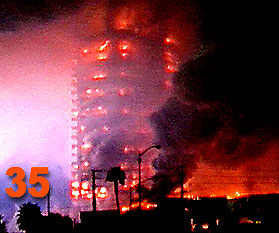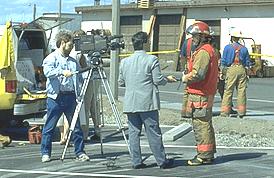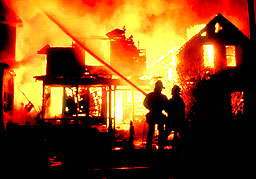|
Film, Radio and TV - 35 |
Updated: 05/15/2005 |
|
Broadcast News Part II
News Sources Broadcast news comes from:
The world's largest newsgathering association, the Associated Press (AP), operates bureaus in 120 U.S. cities and in more than 130 foreign countries, reaching one-third of the world's population. In addition to the AP, there are also smaller wire services, including those operated by large newspapers. Today, stations have computerized newsrooms, and the steady stream of news from these services is electronically written onto a computer hard disk. Using a computer terminal, a news editor can quickly scroll through an index of stories that have been electronically stored. Key words and phrases are used to find stories relating to specific topics. The stories can be called up, edited as needed, printed out for production personnel, and fed to a studio prompter for on-camera reading. Television stations affiliated with a network and O-and-O stations (those owned and operated by a network) receive daily afternoon and evening satellite feeds of news stories provided by network news reporters and affiliated TV stations. Since most of these stories are not used on the network's nightly news, they make good regional, national, and international segments for local newscasts. Independent
stations (those not affiliated with a network)
have television news services they can Whatever the source, the news feeds are videotaped and reviewed by the local news producer or editor. Stories selected for broadcast are normally saved to a video server, or assembled on videotapes and "rolled into" the local news as needed. Regional, national, or even international stories can often be developed from a local perspective. As examples, a major event that takes place in a foreign country can elicit reactions from local people of the same nationality, a crime wave in an adjoining county may cause local people to react, or a shakeup in a New York company may impact employees or related businesses in the station's area. A balance between local, regional, national and international stories must be considered. Plus, you need to consider the important element of visual variety, which involves a balance between ENG segments and stories that are simply read on-camera with supporting graphics. Although the anchor point for most newscasts is a TV studio, TV audiences like the visual variety and authenticity associated with news segments done outside the studio.
After the Sept. 11, 2001 terrorist attacks on the East Coast of the United States all of the news sources had a momentary jump in viewers, but this soon levelled off. Even so, you'll note that television remains the number one source of news and information. The exception to the overall downward trend is the Internet, which has been rapidly increasing in popularity. In fact, among college students the Internet is now the number one source of news and information.
Blogs -- short for Web logs -- are now read by about 30% of Internet users and many news organizations. The writers of blogs use web sites to post personal reactions to events, news of the day, rumors, and even their own personal diaries. Blogs, can be highly opinionated and include unsubstantiated information. Even so, the more valued ones are often the source of leads that the mainstream media develop into major stories.
The number and type of positions involved in producing a daily newscast will vary from two or three people in a very small station, to more than 100 in Toronto, New York, Los Angeles, or Tokyo.
Larger stations have segment producers in charge of specific stories or newscast segments. Some stations will have an executive producer who is over the producer(s). Two types of directors are involved in putting the newscast on the air. The first, the news director, is the top person in the News Department. This person controls the budget, hires and fires personnel, and has ultimate responsibility for the station's news. Much further down the ladder of responsibility is the on-air director for the newscast. This person's responsibility is to take the plans of the producer and "call the shots" in the on-air phase of the broadcast. As the title suggests, the ENG coordinator starts with the story assignments made by the assignment editor and works with reporters, ENG crews, editors, technicians, and the producer to see that the stories make it to "air." ENG coordinators must not only thoroughly know their studio and location equipment, but also understand news.
Although most
local assignments are rather routine, during major accidents, emergencies and disasters,
news and documentary personnel can face definite hazards. Reporters quickly learn that people can go into a kind of "shock fog" during crises, and cannot always be counted on to respond rationally. Add to this the fact that a crew will be working under its own deadline-related pressures, and it becomes obvious that special precautions must be observed in covering this type of news. Once reporters leave the arena of local news, risks can become even greater. Last year more than 75 news people were killed (or "disappeared") around the world. Many were killed or imprisoned in countries where there is fear that a free flow of accurate information would threaten the political power of those in control. For example,
a moving documentary was recently aired showing the atrocities Widespread instances of torture, rape, amputations and murder were documented by Saira Shah through the use of a hidden video camera. In a country where women were forced to beg
for themselves and their children because they were prevented from working and even
from going to school, the reporter clearly risk her life to get the footage. As
a result, she influenced world thinking about the Taliban. (A Forum letter
related to this can be If you are interested in
being a foreign correspondent, you should rent the film, The highly rated film, which is based on a true story, makes use of actual news footage to very dramatically (Note: and very graphically) show what war correspondents face. Welcome to Sarajevo, not only shows that reporters can make a positive difference in the world, but the film gives everyone a lot to think about. For reporters, danger isn't just limited to foreign locations. Even in the United States, investigative reporters working on sensitive stories have been threatened and even killed before they could broadcast their findings. Numerous books and articles document this. Although some of these authors might be viewed as "conspiracy theorists," the death of many journalists and scores of informants on the eve of important revelations can't all be viewed as coincidence. When it comes to politics, great effort often goes into trying to keep certain things from becoming public. It has been well documented that tons of embarrassing documents are marked "classified," even though they have nothing to do with national security. To help address this issue, The Freedom of Information Act was passed that allows citizens and reporters access to some government documents. Although the process of obtaining documents can be fraught with red tape and delays, and key information is often blacked out, The Freedom of Information Act was a major step forward for investigative journalism. After 2001, however, the government reportedly and unofficially passed down notice to the Department of Justice not to enforce this law if government agencies preferred not to reveal documents. Although bringing to light wrongdoing can be fraught with problems, once corruption and wrongdoing are exposed to public view, corrective action often follows. This is one of the things that can make news and documentary work highly rewarding, both personally and professionally. There are many agencies that monitor news
freedom and attempts to censor news. One of these is the
In the next module we'll start
a two-part series on the legal, moral, and ethical aspects of broadcasting.
|
To next module
To index
© 1996 - 2005, All Rights
Reserved.
|

 subscribe
to, including the Cable News Network (CNN).
subscribe
to, including the Cable News Network (CNN). You
will note from the graph on the right that almost all of the traditional news sources
have been losing viewers or subscribers over the past seven years.
You
will note from the graph on the right that almost all of the traditional news sources
have been losing viewers or subscribers over the past seven years. Although
responsibilities vary among stations, generally the news producer
is the person who is directly in charge of the newscast. He or she makes the major
minute-by-minute decisions on both the technical and content aspects of the newscast.
Although
responsibilities vary among stations, generally the news producer
is the person who is directly in charge of the newscast. He or she makes the major
minute-by-minute decisions on both the technical and content aspects of the newscast.
 being
committed on the people of Afghanistan by the Taliban, the ultraconservative, militant
religious group reportedly behind the September terrorists acts on the East Coast
of the U.S.
being
committed on the people of Afghanistan by the Taliban, the ultraconservative, militant
religious group reportedly behind the September terrorists acts on the East Coast
of the U.S.  Welcome
to Sara, starring Stephen Dillane and Woody Harrelson.
Welcome
to Sara, starring Stephen Dillane and Woody Harrelson.